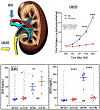Mammalian organ regeneration in spiny mice
- PMID: 36131170
- PMCID: PMC12154453
- DOI: 10.1007/s10974-022-09631-3
Mammalian organ regeneration in spiny mice
Abstract
Fibrosis-driven solid organ failure is a major world-wide health burden with few therapeutic options. Spiny mice (genus: Acomys) are terrestrial mammals that regenerate severe skin wounds without fibrotic scars to evade predators. Recent studies have shown that spiny mice also regenerate acute ischemic and traumatic injuries to kidney, heart, spinal cord, and skeletal muscle. A common feature of this evolved wound healing response is a lack of formation of fibrotic scar tissue that degrades organ function, inhibits regeneration, and leads to organ failure. Complex tissue regeneration is an extremely rare property among mammalian species. In this article, we discuss the evidence that Acomys represents an emerging model organism that offers a unique opportunity for the biomedical community to investigate and clinically translate molecular mechanisms of scarless wound healing and regeneration of organ function in a mammalian species.
Keywords: Acomys; Evolution; Fibrosis; Wound healing.
© 2022. The Author(s), under exclusive licence to Springer Nature Switzerland AG.
Conflict of interest statement
Figures




References
-
- Abbasi S, Sinha S, Labit E, Rosin NL, Yoon G, Rahmani W, Jaffer A, Sharma N, Hagner A, Shah P, Arora R, Yoon J, Islan A, Uchida A, Chang CK, Stratton JA, Scott RW, Rossi FMV, Underhill TM, Biernaskie J (2020) Distinct regulatory programs control the latent regenerative potential of dermal fibroblasts during wound healing. Cell Stem Cell 27:396–412. 10.1016/j.stem.2020.07.008 - DOI - PubMed
-
- Allan CH, Fleckman P, Fernandes RJ, Hager B, James J, Wisecarver Z, Satterstrom FK, Gutierrez A, Norman A, Pirrone A, Underwood RA, Rubin BP, Zhang M, Ramay HR, Clark JM (2006) Tissue response and Msx1 expression after human fetal digit tip amputation in vitro. Wound Repair Regen 14:398–404. 10.1111/j.1743-6109.2006.00139.x - DOI - PubMed
-
- Andres-Mateos E, Mejias R, Soleimani A, Lin BM, Burks TN, Marx R, Lin B, Zellars RC, Zhang Y, Huso DL, Marr TG, Leinwand LA, Merriman DK, Cohn RD (2012) Impaired skeletal muscle regeneration in the absence of fibrosis during hibernation in 13-lined ground squirrels. PLoS ONE 7:e48884. 10.1371/journal.pone.0048884 - DOI - PMC - PubMed
Publication types
MeSH terms
Grants and funding
LinkOut - more resources
Full Text Sources

